
Guests
- John Craneformer senior official at the Pentagon who has revealed major privacy and security lapses within the government’s whistleblower program. He worked 25 years for the Department of Defense Office of Inspector General, which helps federal employees expose abuse.
- Mark Hertsgaardcorrespondent at The Nation magazine and author of several books, including, most recently, Bravehearts: Whistle-Blowing in the Age of Snowden.
Mark Hertsgaard broke the story of Pentagon whistleblower John Crane in his new book, “Bravehearts: Whistle-Blowing in the Age of Snowden.” The book details how senior Pentagon officials may have broken the law to punish National Security Agency whistleblower Thomas Drake for leaking information about waste, mismanagement and surveillance. “I think that’s what’s important about John Crane’s story, is it puts the lie to what Barack Obama and Hillary Clinton are saying and have been saying about Edward Snowden from the beginning,” Hertsgaard said.
Transcript
AMY GOODMAN: We’re in New York with this Democracy Now! broadcast exclusive with John Crane, former senior official at the Pentagon, who has revealed major privacy and security lapses within the government’s whistleblower program. For 25 years, he worked for the Department of Defense Inspector General’s Office, which helped federal employees, both in the Pentagon, at the NSA, expose abuse and corruption. And we’re joined by Mark Hertsgaard, who is the author of the new book, Bravehearts: Whistle-Blowing in the Age of Snowden, which recounts for the first time John Crane’s story. You call him the third man, Mark. Why?
MARK HERTSGAARD: Well, because, as you said at the top of the show, everybody knows what Snowden did at this point, but to really understand it, what Snowden did and why he did it the way he did it—he did it, you need to know the stories of two other men. And one is Thomas Drake, as you said, and the other is the third man. And that third man is Mr. John Crane. And I called him that partly because I needed to keep his identity confidential myself, until we broke the story here today in New York on Democracy Now!, but also in The Guardian and Der Spiegel newspapers. And I chose to work with The Guardian and Der Spiegel because they broke the original Snowden stories, and they understood just how significant Crane’s revelations are, because when you see everything that John Crane tells us about how the whistleblower protection system inside the Pentagon is broken, only results in a whistleblower having his life ruined, as we saw with Tom Drake, you see that really Edward Snowden had no other choice but to go public.
I guess he had two choices. He could have remained silent about the NSA surveillance and then continued to leave the public in the dark about the fact that the United States government was conducting mass, warrantless surveillance, illegal surveillance. He could have done that, but Snowden decided, for reasons of conscience, he could not remain silent. He could have gone Tom Drake’s direction and ended up destroyed like Tom Drake. So, instead, Snowden went out and went public. And he did kind of what Daniel Ellsberg did 40 years ago with the Pentagon Papers, which is to say, “I’m going to take these documents. I’m going to give them to the press.” And as you said in that quote at the top of the hour, from The Guardian report yesterday, Snowden says, “Look, going to the press is not without its risks”—you know, Snowden is now living in exile—”but at least you have a chance—at least you have a chance to get the news out.”
And so I think that’s what’s important about John Crane’s story, is it puts the lie to what Barack Obama and Hillary Clinton are saying and have been saying about Edward Snowden from the beginning. “He broke the law, bring him home. He should face the music,” is what Hillary Clinton said. “Face the music. He could have been a whistleblower,” Hillary Clinton added, “and he would have gotten a very good reception, I think.” Well, I would just like to invite Secretary Clinton, tell that to Thomas Drake, tell that to John Crane, that you would have gotten a good reception by following the whistleblower law inside of the Pentagon.
AMY GOODMAN: So, I want to go to part of what Edward Snowden responded to Crane’s revelations in The Guardian. He said, “We need iron-clad, enforceable protections for whistleblowers, and we need a public record of success stories. Protect the people who go to members of Congress with oversight roles, and if their efforts lead to a positive change in policy—recognize them for their efforts. There are no incentives for people to stand up against an agency on the wrong side of the law today, and that’s got to change.” I also want to go to President Obama and Hillary Clinton. In a 2014—during a press conference in 2013, President Obama was asked about NSA whistleblower Edward Snowden. This is what he said.
PRESIDENT BARACK OBAMA: The fact is, is that Mr. Snowden has been charged with three felonies. If, in fact, he believes that what he did was right, then, like every American citizen, he can come here, appear before the court with a lawyer and make his case. If the concern was that somehow this was the only way to get this information out to the public, I signed an executive order, well before Mr. Snowden leaked this information, that provided whistleblower protection to the intelligence community, for the first time. So there were other avenues available for somebody whose conscience was stirred and thought that they needed to question government actions.
AMY GOODMAN: OK, the president says he signed an executive order that would protect whistleblowers. John Crane, you were a top official in the Pentagon in the Inspector General’s Office. You were there within the whistleblowers protection unit.
JOHN CRANE: Right.
AMY GOODMAN: Is what President Obama’s saying true?
JOHN CRANE: There are fact patterns that he was of course not aware of. The General Accountability Office, which is the investigative arm of the Congress, that they have issued two separate reports on the IG DOD whistleblower program. In one of the reports, they say that one-quarter of all IG employees fear reprisal. In a federal employee climate survey, one-third of all reprisal investigators fear reprisal. So, we have a situation here, based—based upon Capitol Hill taking in trust, showing that those investigators trying to actually prove reprisal are themselves retaliated against when they try to make findings substantiating reprisal. So, that’s a dynamic that no one within the White House would have understood.
AMY GOODMAN: I want to go from the president to the person who wants to be president, Hillary Clinton, the former secretary of state. This is a 2014 interview she did with The Guardian, where she said NSA whistleblower Edward Snowden should return to the U.S. if he’s serious in engaging in debate about privacy and security.
HILLARY CLINTON: Well, I would say, first of all, that Edward Snowden broke our laws, and that cannot be ignored or brushed aside. Secondly, I believe that if his primary concern was stirring a debate in our country over the tension between privacy and security, there were other ways of doing it, instead of stealing an enormous amount of information that had nothing to do with the U.S. or American citizens. I would say, thirdly, that there are many people in our history who have raised serious questions about government behavior. They’ve done it either with or without whistleblower protection, and they have stood and faced whatever the reaction was to make their case in public. …
I don’t know what he’s been charged with. Those are sealed indictments. I have no idea what he’s been charged with. I’m not sure he knows what he’s been charged with. But even in any case that I’m aware of, as a former lawyer, he has the right to mount a defense. And he certainly has a right to mount both a legal defense and a public defense, which of course can affect the legal defense.
AMY GOODMAN: I remember this interview very well that Hillary Clinton did with The Guardian in 2014, because I learned about it just as I was walking up the steps of the Ecuadorean Embassy in London to interview Julian Assange, who is holed up there, and June 19th will be his fourth year in captivity. He’s gotten asylum in Ecuador, but he fears if he steps outside, he will be arrested and ultimately extradited to the United States, fears he could be charged with treason. But what Hillary Clinton said, John Crane, about him coming back to this country, and he could launch a vigorous legal and public defense, John Snowden—I mean, Edward Snowden?
JOHN CRANE: Yes, yes. I think that in terms of when you think whether or not you should be a whistleblower, that you’re concerned about whether or not the system works. And there are various statistics out there, from the IG DOD semi-annual report, for instance, that in regard to the way the IG even investigates senior officials, over a two-and-a-half-year period, regarding senior officials in the Army, that the IG DOD received 482 allegations, accepted 10 allegations, substantiated one allegation.
AMY GOODMAN: Of 404, the Inspector General’s Office in the Pentagon, in the Department of Defense—
JOHN CRANE: Substantiated one, which is 0.2 percent. The Army, however, also investigating senior officials, under IG DOD oversight, they had 372 allegations. They investigated all 372 allegations. They had 102 substantiated. They had a 27 percent substantiation rate. So, this is a very major statistical anomaly. Why does the Army, looking at the same group of senior officials, have a 27 percent substantiation rate versus the IG with a 0.2 percent?
AMY GOODMAN: I want to go back to the case of Tom Drake.
JOHN CRANE: Yes.
AMY GOODMAN: You allege documents were destroyed.
JOHN CRANE: I don’t allege that. Documents were destroyed. Because when the IG DOD—
AMY GOODMAN: You said you don’t allege that, that in fact you know that documents were destroyed.
JOHN CRANE: Because that is what the IG DOD said. Documents were destroyed according to a standard document destruction policy. And that was a statement that they made to the Department of Justice in regard to the Drake trial, because Drake’s attorneys wanted to find exculpatory information. The IG DOD response was, it just doesn’t exist.
AMY GOODMAN: It had existed.
JOHN CRANE: It had existed, and it should have existed.
MARK HERTSGAARD: Yeah, they made sure it didn’t exist.
AMY GOODMAN: Mark Hertsgaard?
MARK HERTSGAARD: They made sure it didn’t exist. I think John is being, perhaps, very diplomatic about his former colleagues. You know, he asked for those documents, and they said, “Oh, we can’t give them to you.” “Why not?” “Well, because they don’t exist anymore.” “Well, why not?” Because somebody”—expletived—”somebody screwed up, and they were destroyed,” in a supposedly routine purge of documents. And, you know, they were, obviously, lying about that. And then, to make it worse, these two individuals, who were then the acting inspector general of the Pentagon and the general counsel, the top lawyer there, they lied—
AMY GOODMAN: Explain who they are.
MARK HERTSGAARD: Yeah. Well, their names are Lynne Halbrooks—she was the acting inspector general—and Henry Shelley, who was the general counsel. And he was the one who said, “We screwed up”—since this is a family program. And he said that they had been destroyed in a routine purge. Of course, governments, they do have to purge a lot of information, but you don’t purge top-secret documents lightly. And then, to make it worse, they then lied to the federal judge in this case about that, assuring the judge that it was—that the documents had been lost in a routine purge. Well, that, of course, is a felony. You cannot lie to a judge in a federal case. You cannot destroy documents. That is called obstruction of justice. And that is really why these two individuals now are in legal jeopardy.
And the Office of Special Counsel, which is an agency inside the United States government that investigates all of the whistleblower issues throughout the government, they looked into the allegations of John Crane. And in March, they issued their report, and they said that there is a, quote, “substantial likelihood” that Mr. Crane’s allegations are correct. What that means—that’s the highest threshold of proof that they could have asserted. And that means that now Henry Shelley, the general counsel, still at the Pentagon’s IG Office, and Lynne Halbrooks, the former assistant inspector general, they are now facing a new investigation. As the OSC finding required, Defense Secretary Ashton Carter has now had to authorize a new investigation into all this. And these are the kinds of crimes—lying to a judge, destroying documents, obstructing justice—if you or I did them, we would be going to jail. We’ll see if these high-ranking Pentagon officials end up going to jail.
AMY GOODMAN: We’re going to break, and when we come back, I want to ask you, John Crane, what gave you the courage to speak out. You have quite a remarkable family history. We are talking with John Crane, former senior official at the Pentagon, and we’re talking with Mark Hertsgaard, who has written the story of John Crane and Thomas Drake in a new book called Bravehearts: Whistle-Blowing in the Age of Snowden. Stay with us.
[break]
AMY GOODMAN: “Obama,” Anohni, here on Democracy Now!, democracynow.org, The War and Peace Report. Today, a former Pentagon official is speaking out for the first time in this broadcast exclusive—John Crane, former senior official at the Pentagon, who’s revealed major privacy and security lapses within the government’s whistleblower program. He worked for a quarter of a century at the Department of Defense Inspector General’s Office, which helps expose—which helps federal employees expose abuse and corruption, both at the Pentagon and the NSA. And we’re joined by Mark Hertsgaard, who tells Crane’s story in Bravehearts: Whistle-Blowing in the Age of Snowden, a new book. What happened to you, John Crane? So you worked there for 25 years; you’re not working there anymore.
JOHN CRANE: Yes. I was summoned into Ms. Halbrooks’ office, and I was simply walked out of the building.
AMY GOODMAN: The Pentagon inspector general at the time.
JOHN CRANE: Pentagon inspector general building. It was not a surprising occurrence.
AMY GOODMAN: When was this?
JOHN CRANE: This was in February 2013, that since I was responsible for the overall whistleblowing program, that within the Inspector General’s Office we had various whistleblowers stepping forward. And they had concerns regarding the audit function. They had concerns the way that we investigated reprisal investigations. And they had contacted Congress. And as the agency head, she asked me to actually identify to her IG employees who were whistleblowers, so that she could have the congressional oversight shut down, because she did not want to have her Senate nomination endangered by them, that she was the acting inspector general, that she wanted to be the permanent inspector general, and she could not afford to have whistleblowers contacting Congress, because that would create questions regarding whether she was qualified for the job that she wanted to have.
AMY GOODMAN: So you were walked out.
JOHN CRANE: I was walked out.
AMY GOODMAN: You were fired.
JOHN CRANE: Physically walked out.


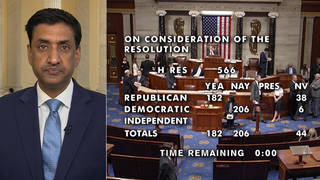
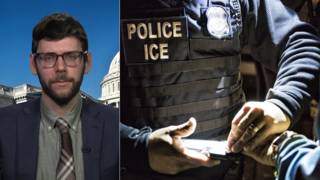

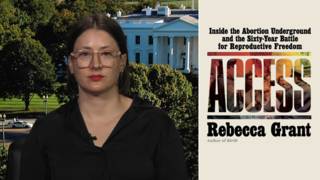

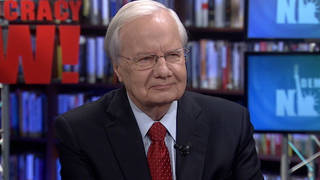




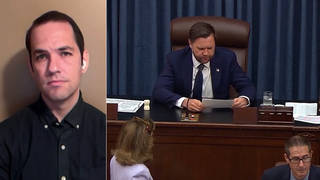

Media Options